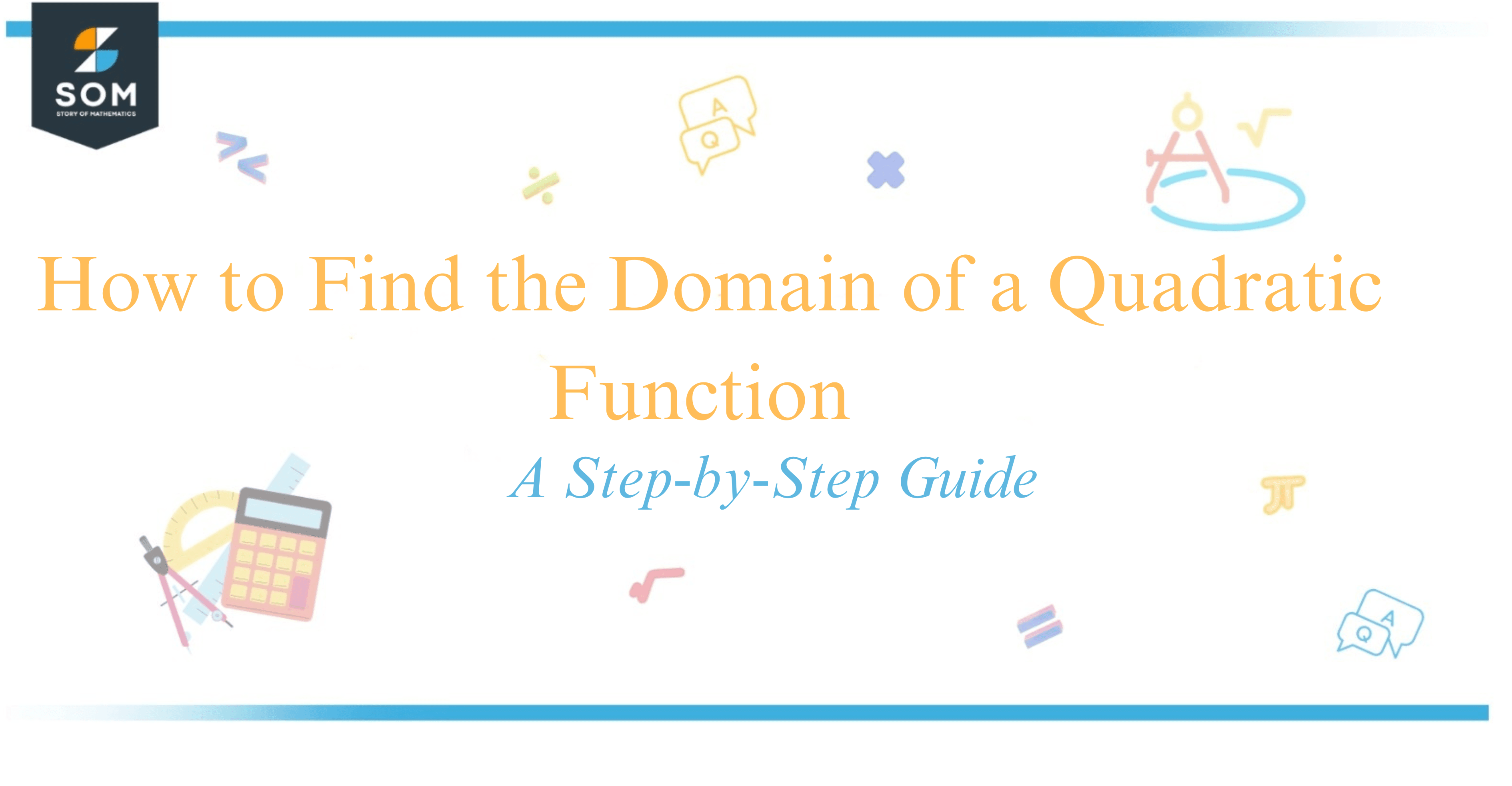JUMP TO TOPIC

To find the domain of a quadratic function, I’ll remind myself that the domain refers to the set of all possible input values (usually x), for which the function is defined.
Since a quadratic function can be written in the form $f(x) = ax^{2} + bx + c $, where ( a ), ( b ), and ( c ) are constants and $ a \neq 0 $, it’s quite straightforward.
The beauty of quadratic functions is that they are defined for all real numbers. This is because the shape of their graph is a parabola that spans horizontally across all x-values.
The rule of thumb here is that the domain of any quadratic function is the entire set of real numbers. That’s $(-\infty, \infty)$ in interval notation. Whenever I process this concept, it simplifies my understanding of how inputs work for quadratic functions.
Remember, no matter what quadratic equation I am dealing with, its domain remains consistently unbounded. This is one of the elegant features that make quadratic functions a fundamental part of the world of functions.
And here’s a hook to keep you engaged: Imagine how knowing this simplicity helps when I’m graphing these functions—no restrictions, no barriers, just a smooth curve that opens either up or down, waiting for us to explore its trajectory.
Determining the Domain of a Quadratic Function
When I examine quadratic function, typically expressed in the general form $f(x) = ax^2 + bx + c$, the first thing I remember is that its domain encompasses all real numbers.
This is because, no matter what real value I plug in for $x$, I will always be able to find a corresponding $y$ value on the parabolic graph, making every real number a valid input.

A quadratic function is a polynomial of degree 2, which creates a parabola when graphed. This parabola can either open upward or downward depending on the coefficient ‘a’. If $a > 0$, the parabola opens upwards, and if $a < 0**, it opens downwards.
Regardless of the direction, the parabola continues infinitely in both the positive and negative direction along the x-axis, suggesting the domain is all real numbers, or in set notation: $D = (-\infty, \infty)$.
The vertex of the parabola represents the minimum or maximum point and falls on the line of the axis of symmetry, which is given by the formula $x = \frac{-b}{2a}$. Although crucial for determining the range, it has no effect on the domain.
For example, if I have the quadratic function $f(x) = 2x^2 – 4x + 1$, I immediately know the coefficient ‘a’ is 2, which means the graph opens upward. However, this factor does not limit the values $x$ can take, confirming the domain is all real numbers.
When giving specific examples or working with a graphing utility or graphing calculator, the parabola will visually demonstrate that it extends endlessly along the x-axis.
This visualization reaffirms my understanding: a quadratic function has no restrictions on its input and thus ‘x’ can be any real number.
Exploring Properties of Quadratic Function Domains
In my experience with quadratic functions, understanding the domain is a fundamental step in graphing and solving equations.
A quadratic function is typically in the form of $f(x) = ax^2 + bx + c$, where $a$, $b$, and $c$ are coefficients, and $a \neq 0$.
Unlike linear functions, which can have any real number as the input, the domain of a quadratic function is all real numbers. This means any real number can be used as the x-coordinate for input.
The reason for this lies in the behavior of polynomial functions. As I plot these functions, I see that they create a continuous curve, and there is no x-coordinate I can think of that is not part of the graph.
Therefore, when I write the domain, it is simply the set of all real numbers, expressed mathematically as $(-\infty, \infty)$.
However, discussing the coefficients of these functions is worthwhile. If the leading coefficient ( a ) is positive, the parabola opens upwards. Conversely, if ( a ) is negative, it opens downwards. This doesn’t alter the domain, but it’s crucial as it affects the range and the function’s graph.
A confusing aspect for some might be the difference between linear functions, with their straightforward line graphs.
I remember thinking that since the quadratic formula $x = \frac{-b \pm \sqrt{b^2 – 4ac}}{2a}$ can produce two numbers, it affects the domain. However, this formula is used for finding the x-coordinates of the function’s zeroes, not its domain.
When dealing with fractional coefficients or whole numbers, the domain remains unaffected.
Whether coefficients are positive, negative numbers, or fractions, the domain still consists of all real numbers, since these changes only affect the position and orientation of the graph, not the input values.
Here’s a quick reference table summarizing the impact of coefficients on the domain:
| Coefficient Type | Impact on Domain |
|---|---|
| Real Numbers | No Change |
| Fractions | No Change |
| Positive | No Change |
| Negative | No Change |
Friendly reminder: Domains reflect possible x-coordinates, and every x-coordinate on the real number line is a valid input for a quadratic function.
Applied Examples and Exercises
When I’m explaining how to find the domain of a quadratic function, I like to start with a clear example. Let’s consider the quadratic function $ f(x) = ax^2 + bx + c$. Remember, the domain of a function is the set of all possible input values of ( x ) that will give a real number output value.
Example 1: For the function $f(x) = 4x^2 – 2x + 7$, the domain is all real numbers, because no matter what ( x ) value I choose, the equation will always result in a real number. Therefore, the domain is expressed as $ (-\infty, \infty) $.
| Function | Domain |
|---|---|
| $f(x) = 4x^2 – 2x + 7$ | $(-\infty, \infty) $ |
Now let’s apply this to a more specific scenario. Imagine I’m tracking the height of a basketball over time, and the path of the basketball is modeled by the function $f(x) = -16x^2 + 40x $. Here the ( c ) term is 0, which simplifies the equation.
Nonetheless, the domain remains the same: all real numbers, since no input value can make the equation undefined.
Moving on to exercises, I’ll often ask students to draw the graph of a quadratic function to visualize why the domain is all real numbers. I typically recommend the following:
- Sketch the graph of $ f(x) = x^2 – x – 6 $ to identify the domain.
- Determine the domain of $f(x) = -2x^2 + 3x + 1 $ by considering all possible outputs.
In summary, finding the domain of a quadratic function isn’t too complicated—just remember that it includes all real numbers since quadratic functions like $f(x) = ax^2 + bx + c $ do not restrict input values for ( x ).
Conclusion
In exploring the domain of quadratic functions, I’ve come to appreciate the simplicity and consistency of these mathematical entities.
Regardless of the quadratic form, the domain is always all real numbers, which I can denote elegantly as $\mathbb{R}$.
This means for any quadratic function $f(x) = ax^2 + bx + c$, where $a$, $b$, and $c$ are real numbers and $a \neq 0$, I can always plug in any real number for $x$.
However finding the range of a function requires a bit more work, involving the determination of the orientation of the parabola based on the coefficient $a$.
If $a > 0$, the parabola opens upwards, and the range is $y \geq k$, where $k$ is the y-coordinate of the vertex of the parabola. Conversely, if $a < 0$, the parabola opens downwards, and the range is $y \leq k$.
Remembering these key characteristics of quadratic functions enables me to quickly navigate the domain and range without confusion. I also make sure to check the leading coefficient to understand the behavior of the range.
All in all, the beauty of mathematics lies in these universal truths that remain consistent across all quadratic functions. It’s these foundations that allow me to build a deeper understanding of more complex mathematical concepts.
